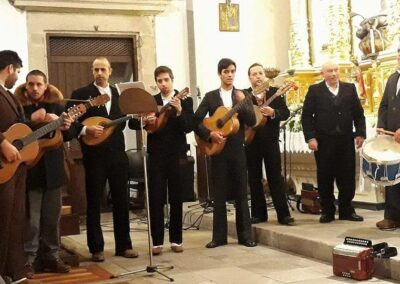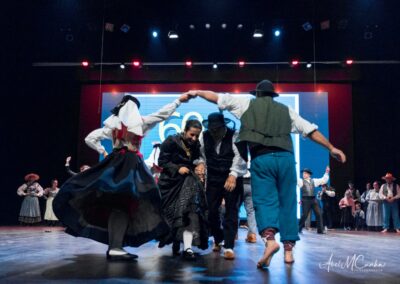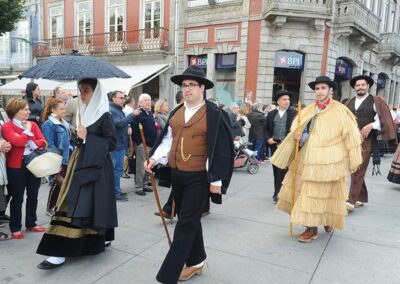MATOSINHOS MUNICIPALITY
Matosinhos is a small urban municipality with 62.42 km² of area and 175,478 inhabitants (2011), subdivided into 4 parishes. The municipality is bordered to the north by the municipality of Vila do Conde, to the northeast by Maia, to the south by Porto and to the west has a coast in the Atlantic Ocean.
On the coast of the city is the port of Leixões, the largest artificial port of Portugal and second maritime port of the Metropolitan Area of Porto. Part of Oporto’s international airport covers municipal boundaries.
The seat of the municipality is the parish of Matosinhos and Leça da Palmeira, from where Rancho Típico da Amorosa is. The main feast in Matosinhos is the Lord of Matosinhos, one of the main and greatest Pilgrimages in Portugal, whose origin is in an ancient legend in which the Image of Jesus Crucified (Nicodemus’s work), here will have appeared by the sea, where there is a Memorial Chapel. The image of the Lord is venerated in the famous Sanctuary of the Lord of Matosinhos (masterpiece by Nicholas Nasoni).
Matosinhos is today a municipality strongly dedicated to the tertiary sector, although it also has industry, mainly petrochemicals, food and canning industries, textiles and electrical equipment, and also has a huge fishing activity. Fishland, Matosinhos is also a decoy to all who like good gastronomy, namely a good grilled fish, to what contributes to the recently created brand “World’s Best Fish”! It is in the city of Matosinhos / Leça da Palmeira, more specifically on the right bank of the Leça River that is located Exponor, the largest business fair area in the country. It also has the most important entrance door to Oporto: the Port of Leixões, the largest artificial port of Portugal, built in the late nineteenth century. Matosinhos is also a municipality with vast cultural and architectural heritage from which stand out the Church of Lord Bom Jesus de Matosinhos, the Standard of Bom Jesus de Matosinhos, the Monastery of Leça do Balio, the Car Bridge, the Obelisk of Memory Beach and, more recently, the Tea House of Boa Nova, the building of the City Hall, the Leixões Cruise Terminal and the House of Architecture.
THE GROUP
Situated on the right bank of the mouth of Leça, (which is 10 km from the city of Porto), this small sailor village was once divided into small places. One of these places, the Amorosa, which was located in the upper part of the parish, lived essentially from agriculture, but the sea, always “kissing the feet” of Leça da Palmeira, would of course have to influence its people.
Rancho Típico da Amorosa was born in the current Union of Parishes of Matosinhos and Leça da Palmeira, in the distant year of 1935, and received, in the first years of its existence, the teaching and the knowledge of the ethnomusicologist Professor Armando Leça. In the honor book of the community, this distinguished figure, rich in the concept of the folklore, at the time, wrote: “While in Rancho Típico da Amorosa endure so beneficial intention, you will have a defender to applaud.” On these 87 years of history, the group has always been in the safeguarding of the immaterial heritage of humanity, bearing the name of Leça da Palmeira, Matosinhos and Portugal, together with its customs and traditions, to the four corners of the world, as attest the numerous presentations from north to south of Portugal, throughout Europe, in Asia and In Latin America.
Rancho Típico da Amorosa essentially represents “Maiato” folklore, because Leça da Palmeira, in the age that the group represents, mid/late nineteenth century, was inserted in the ancient lands of Maia, which of course influences the attire and the repertoire that the group currently present. Rancho Típico da Amorosa is the organizer of FESTARTE (International Festival of Popular Arts and Traditions of Matosinhos), CIOFF Festival (an NGO that enjoys status B with UNESCO). It is also a founding partner of the Portuguese Folklore Federation and It has been distinguished throughout the years by several public and private agencies, for its merit and service to the Portuguese Popular culture.
As we explain in a more detailed way, the group participates in the major festivals in Portugal, and also as travelled to many countries in Europe, as well to Asia and South America
COSTUMES OF THE GROUP
In spite of Leça da Palmeira is a land by the sea, the place of Amorosa, from where Rancho Típico da Amorosa originates, was eminently agricultural. That is why the working suits are alluding, essentially, to agriculture, the main activity of that small place.
In addition to the work attire, the group also shows Sunday and luxury costumes, all of which are faithful replicas of what were worn by our ancestors in the late nineteenth century, early twentieth century
MUSIC AND DANCES
The Orchestra of the group is composed by several instruments, namely concertinas, mandolins, “cavaquinhos”, “violas braguesas”, guitars, bass drum, triangle and “reco-reco”, a traditional Portuguese guiro.
The group only performs with live music, in all kind of shows, on stage, on the floor or in a parade. We try to preserve the portuguese traditional culture, playing only traditional instruments
The dances that the group performs represent what Leça da Palmeira population danced on those days (end of 19th century, beginning of 20th) . The dances are very different: we have dances in column, square dances and circle dances.
Beyound the dances, the group also performs other shows, like traditional ethnographic spectacle «Tradições de Leça», where we present the traditions of our parish along the entire year, from January to December.
Rancho Típico da Amorosa also performs, every year, Carols of the Christmas Cycle.
The group has also recorded a CD, on 2019, which intends to preserve the traditions of Leça da Palmeira and Matosinhos through all the years.
RANCHO TÍPICO DA AMOROSA ALL OVER THE WORLD
International Folk Festival – Rodez – France International Folk Festival, Nancy – France Fêtes de La Vigne, Dijon – France Mostra Internacional de Folklore, Soller –, Mallorca – Spain International Folk Festival, Mahon, Menorca – Spain Festival Internazionale del Folclore e delle Tradizioni, Bergamo – Italy Mostra Folklorica Internacional de Viveiros, Viveiros – Spain Lefkas International Folklore Festival, Lefkas – Greece Madrid, Spain Villalba International Folklore Festival, Villalba – Spain Festival de Danses de l’Antiga Corona d’Aragó, Castellón de La Plana – Spain International Folk Festival, Amnéville – France Enschede International Folk Festival, Enschede – Netherlands International Folk Festival, Custonaci – Italy International Folk Festival, Tainan – Taiwan Festival International de Folklore de Argentina – Argentina Summerfest – Hungary International Folklore Festival, Santander – Spain International Festival of Folklore, Zielona Gora – Poland GYÖNGY International Folklore Festival – Hungary Festival Internacional de Folklore de Zamora, Zamora – Spain
Artistic director Lukasz Chojnacki




